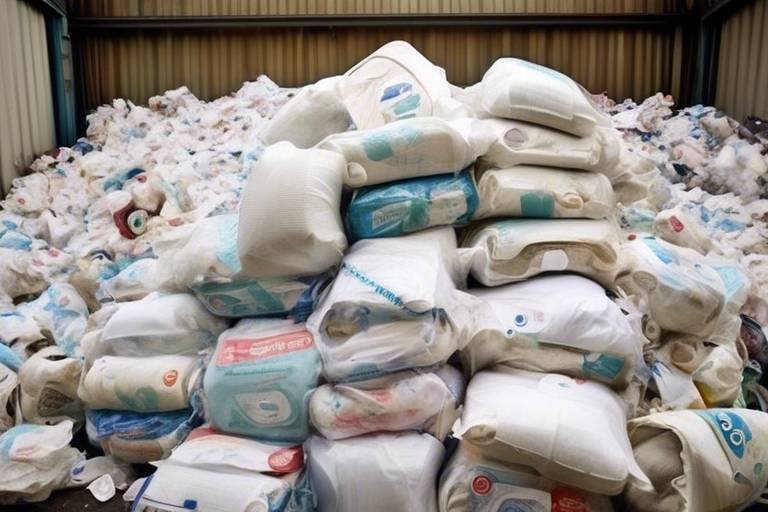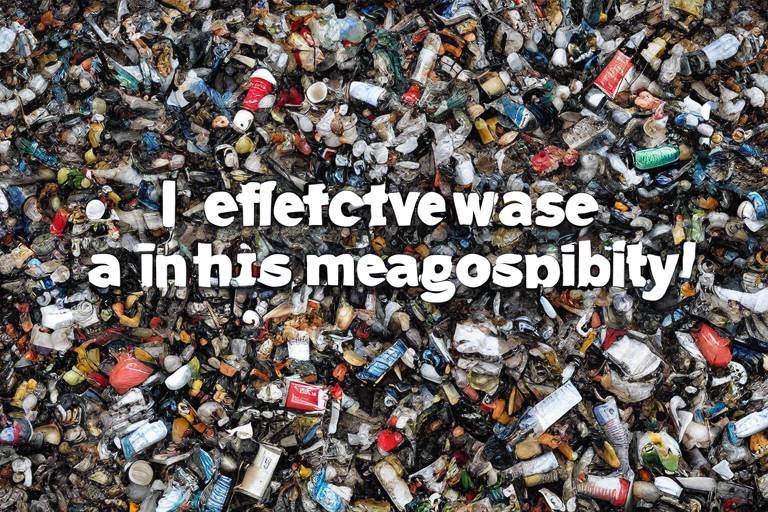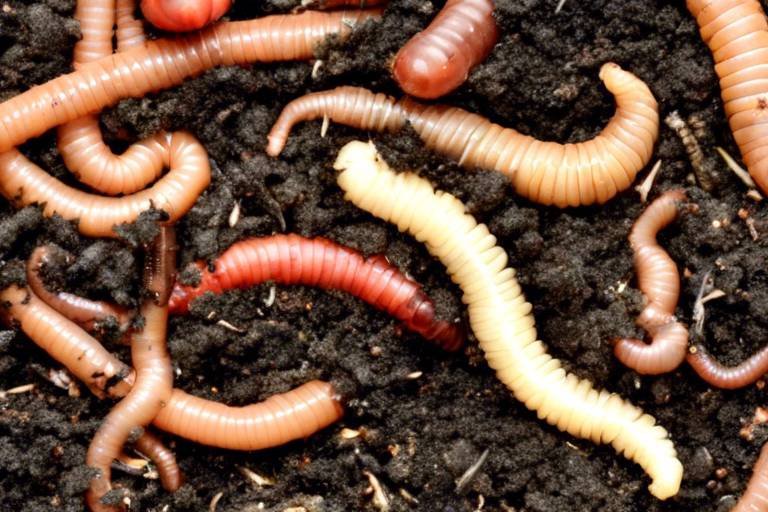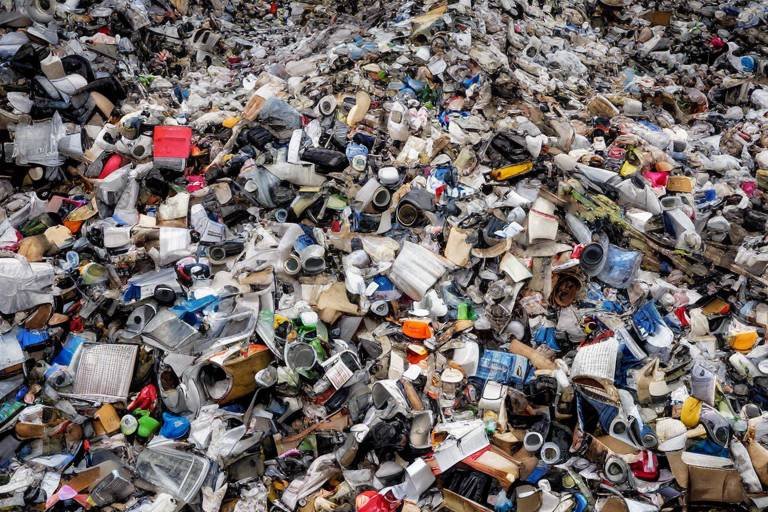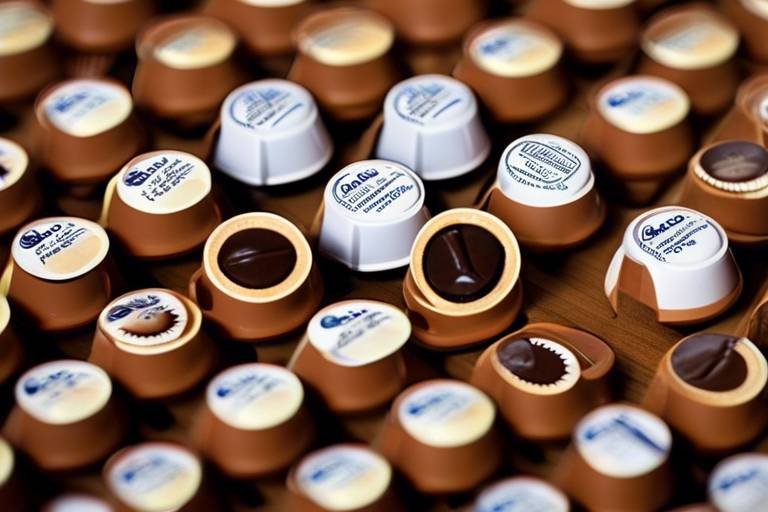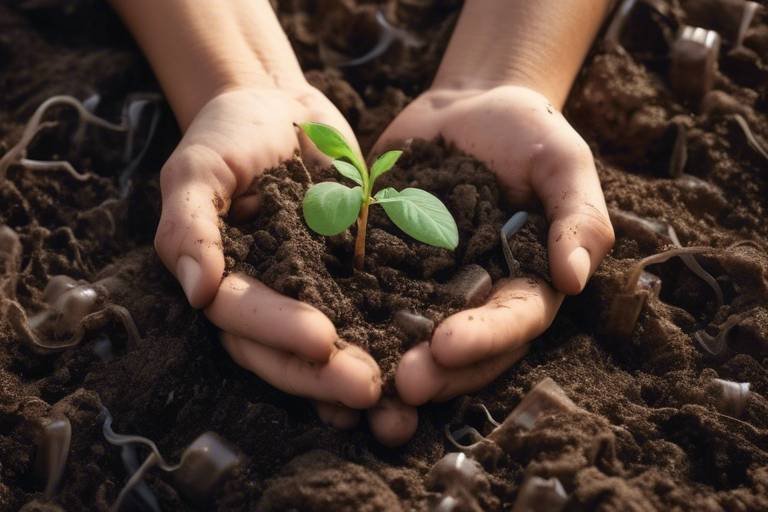Top 10 Unconventional Materials that Can be Recycled
This article explores innovative and unexpected materials that can be recycled, highlighting their environmental benefits and potential uses. Discover how recycling these items can contribute to a more sustainable future.
Denim, often discarded after its prime, is more than just a fabric; it holds the potential to be transformed into a variety of useful products. The process of recycling denim involves shredding the fabric and then using it as insulation, stuffing for cushions, or even spinning it back into new fabric. This not only reduces waste but also promotes sustainability in the fashion industry, which is notorious for its environmental impact. Imagine turning your old jeans into cozy insulation for a home or a trendy new jacket! By recycling denim, we can significantly reduce the amount of textile waste that ends up in landfills, making a positive contribution to our planet.
Used coffee grounds are often tossed away without a second thought, but they are a treasure trove of nutrients! Rich in nitrogen, they can be recycled into compost for gardening, providing an excellent natural fertilizer for plants. Additionally, coffee grounds can serve as natural exfoliants in skincare routines, helping to scrub away dead skin while being gentle on the environment. Instead of throwing out those grounds, think about how they can nourish your garden or enhance your self-care rituals. It's a win-win situation that transforms waste into something valuable!
Old electronics, or e-waste, is a growing concern in today's tech-driven world. These devices contain precious metals and materials that can be recovered and reused. When we recycle our old gadgets, we not only prevent harmful chemicals from leaching into the environment but also conserve valuable resources. The recycling process for e-waste involves dismantling devices to extract metals like gold, silver, and copper, which can then be used in new products. Imagine the impact of recycling just one smartphone—it's like giving a second life to materials that would otherwise be lost forever!
Plastic bags are ubiquitous in our daily lives, yet many of them end up in landfills where they can take hundreds of years to decompose. However, these bags can be recycled into new products, such as composite lumber, which is used for outdoor furniture and decking. The recycling process involves cleaning and melting the plastic, transforming it into pellets that can be molded into various items. By recycling plastic bags, we can significantly reduce the environmental harm they cause. So next time you have a plastic bag, consider taking it to a recycling center instead of tossing it in the trash!
Wine corks are often overlooked in recycling efforts, but they can be repurposed in numerous creative ways. From crafting unique home decor to being used as insulation in eco-friendly building projects, corks have a lot to offer. They can even be ground down and used in flooring! Recycling wine corks not only helps reduce waste but also supports sustainable practices. So, the next time you pop a bottle, think about saving that cork—it might just spark your next DIY project!
Toothbrushes, typically made of plastic, contribute to the growing problem of plastic waste. However, many companies now offer recycling programs for old toothbrushes. These brushes can be transformed into new products, such as plastic lumber or even recycled back into new toothbrushes. Additionally, toothbrushes can be repurposed for various cleaning tasks around the house. By taking the time to recycle or repurpose your toothbrush, you can help reduce plastic waste while also finding a practical use for an otherwise discarded item.
Glass jars are the unsung heroes of recycling! They can be recycled repeatedly without losing quality, making them an incredibly sustainable option. The recycling process for glass involves crushing the jars into small pieces, melting them down, and reforming them into new glass products. Beyond recycling, glass jars can also be repurposed in countless ways—think storage containers, vases, or even candle holders. Their versatility makes them a fantastic material to keep out of the landfill.
Used tires are often seen as waste, but they can be transformed into a variety of useful products. Through innovative recycling methods, old tires can be turned into rubber mulch for playgrounds, surfaces for sports fields, or even used in road construction. This not only helps reduce waste but also provides durable materials for various applications. By recycling old tires, we can give them a new lease on life while also benefiting the environment.
Paper products like magazines and newspapers are often discarded without a second thought, yet they can be recycled into new paper products. The recycling process involves breaking down the paper fibers and reforming them into sheets of new paper. By recycling paper, we conserve resources and reduce the need for deforestation. It's a simple act that can have a significant impact on our environment. So, the next time you finish reading a magazine, consider recycling it instead of tossing it in the trash!
Q: Can all types of denim be recycled?
A: Most denim can be recycled, but it's best to check with your local recycling program to see if they accept it.
Q: How can I recycle my old electronics?
A: Many retailers offer e-waste recycling programs, or you can find local e-waste recycling centers in your area.
Q: What should I do with plastic bags?
A: Instead of throwing them away, take your plastic bags to a designated recycling drop-off location.
Q: Are there any specific ways to recycle wine corks?
A: Yes! You can check for local cork recycling programs or use them in crafts and DIY projects.
Q: How can I reduce my plastic waste from toothbrushes?
A: Consider using bamboo toothbrushes, which are biodegradable, or participate in recycling programs for plastic toothbrushes.

1. Denim
This article explores innovative and unexpected materials that can be recycled, highlighting their environmental benefits and potential uses. Discover how recycling these items can contribute to a more sustainable future.
Denim is more than just a fashion staple; it’s a surprising hero in the recycling world! Often discarded after a few years of wear, denim can actually be transformed into a variety of useful products. The process of recycling denim is not only beneficial for the environment but also promotes sustainability in the fashion industry. By recycling denim, we can significantly reduce the amount of textile waste that ends up in landfills. Imagine turning your old jeans into cozy insulation for homes or even stuffing for furniture! How cool is that?
So, what does the recycling process look like? First, the denim is collected and sorted. Then, it undergoes shredding, where it’s broken down into fibers. These fibers can be processed into new materials, such as:
- Insulation: Denim is an excellent insulator, keeping homes warm in winter and cool in summer.
- Stuffing: Old denim can be used as stuffing for pillows and cushions, providing comfort and support.
- New Fabric: Surprisingly, recycled denim can be woven back into new fabric, ready for another round of fashion!
The environmental benefits of recycling denim are immense. For instance, producing new denim from recycled materials uses less water and fewer chemicals compared to creating denim from virgin cotton. In fact, it takes about 7,000 gallons of water to produce just one pair of jeans! By recycling, we conserve precious resources and reduce our carbon footprint.
Furthermore, recycling denim helps to combat the fast fashion industry’s negative impact on the environment. Fast fashion leads to a significant amount of waste, but by choosing to recycle, consumers can play a part in creating a more sustainable fashion ecosystem. It’s like giving your jeans a second life, and who wouldn’t want to do that?
In conclusion, denim recycling is a fantastic way to turn something that might otherwise be thrown away into valuable resources. Whether it’s insulation for homes or trendy new fabric, the possibilities are endless. So next time you’re about to toss out those old jeans, think twice! You could be contributing to a greener planet.
Q: Can all denim be recycled?
A: Yes, most denim can be recycled, but it’s best to check with local recycling programs for specific guidelines.
Q: How can I recycle my old denim?
A: You can donate your old denim to clothing banks, send it to denim recycling programs, or even repurpose it at home!
Q: What are some creative ways to reuse old denim?
A: Consider making bags, quilts, or even home decor items from your old denim. The options are endless!

2. Coffee Grounds
Coffee is more than just a morning ritual; it’s a powerhouse of potential that often ends up in the trash. Did you know that used coffee grounds are not just waste? They are a treasure trove of nutrients and can be recycled in various innovative ways that not only benefit your home but also the environment. Imagine transforming your morning brew's leftover grounds into something useful rather than letting them languish in a landfill.
One of the most common uses for recycled coffee grounds is in gardening. These grounds are rich in nitrogen, making them an excellent addition to compost piles. When added to your compost, they help create a balanced environment for microorganisms, which is essential for breaking down organic matter. Additionally, coffee grounds can be sprinkled directly into the soil as a natural fertilizer, providing plants with the nutrients they need to thrive.
But the benefits don’t stop at gardening! Coffee grounds can also serve as a natural exfoliant for your skin. Many skincare enthusiasts rave about the effectiveness of coffee scrubs, which can help remove dead skin cells, improve circulation, and even reduce the appearance of cellulite. By simply mixing coffee grounds with a bit of coconut oil or yogurt, you can create a luxurious scrub that’s both eco-friendly and effective.
Here’s a quick overview of some surprising uses for those leftover coffee grounds:
- Odor Neutralizer: Place dried coffee grounds in your refrigerator or freezer to absorb unwanted odors.
- Cleaning Abrasive: Use them to scrub pots and pans; their gritty texture makes them a natural abrasive.
- Pest Repellent: Sprinkle coffee grounds around your garden to deter pests like slugs and snails.
By recycling coffee grounds, you are not only reducing waste but also contributing to a more sustainable lifestyle. It’s a win-win situation! The next time you brew a pot of coffee, think about all the ways you can reuse those grounds. Not only will you be helping the planet, but you’ll also be adding value to your daily routine.
Q: Can I compost coffee grounds?
A: Absolutely! Coffee grounds are a great addition to compost as they are rich in nitrogen.
Q: How do I use coffee grounds in my garden?
A: You can mix them into the soil or compost, or sprinkle them around plants as a natural fertilizer.
Q: Are coffee grounds safe for all plants?
A: Most plants benefit from coffee grounds, but it’s best to use them in moderation, as too much can lead to acidity in the soil.

3. Old Electronics
In our fast-paced digital world, old electronics often become obsolete quicker than we can keep up. Think about it: how many smartphones, laptops, or tablets have you cycled through in just a few years? The reality is, these devices contain a treasure trove of precious metals and materials that can be recovered and reused. When we talk about recycling old electronics, we're not just discussing the act of disposing of them responsibly; we're diving into a world of sustainability and innovation.
Many people are unaware that e-waste, as it’s commonly known, is one of the fastest-growing waste streams globally. According to the United Nations, around 50 million tons of e-waste is generated each year, and less than 20% of it is recycled properly. This is a staggering statistic that highlights the urgent need for more awareness and action. By recycling old electronics, we can significantly reduce the environmental impact of improper disposal, which can lead to toxic substances leaching into our soil and water systems.
So, what happens when you recycle your old electronics? The process typically involves several steps:
- Collection: Old electronics are gathered from consumers, often through designated drop-off points or collection events.
- Sorting: Devices are sorted based on their type and materials, ensuring that hazardous components are handled separately.
- Processing: The electronics are dismantled, and valuable materials like copper, gold, and plastics are extracted for reuse.
- Recycling: The extracted materials are then processed and transformed into raw materials that can be used in new products.
Recycling old electronics not only conserves resources but also reduces the need for mining new materials, which can be environmentally destructive. For instance, recycling just one million laptops can save enough energy to power over 3,500 homes for a year! This is a significant win for both the environment and our energy consumption.
Moreover, many companies have started to recognize the importance of e-waste recycling. Some brands even offer trade-in programs where you can exchange your old devices for discounts on new purchases. This not only incentivizes consumers to recycle but also promotes a circular economy where products are reused and repurposed rather than discarded.
In conclusion, recycling old electronics is a crucial step towards a more sustainable future. By taking the time to properly dispose of our outdated gadgets, we can help minimize environmental harm and contribute to the recovery of valuable materials. So next time you're tempted to toss that old phone in the trash, remember: it holds more value than you think!
Q: What types of electronics can be recycled?
A: Most electronics can be recycled, including smartphones, computers, tablets, televisions, and gaming consoles. Always check with your local recycling program for specifics.
Q: How can I find a recycling program for my old electronics?
A: Many retailers and local governments have e-waste recycling programs. Websites like Earth911.com can help you locate a recycling center near you.
Q: Are there any risks associated with recycling electronics?
A: When done properly, recycling electronics is safe and environmentally beneficial. However, ensure you use certified e-waste recyclers to avoid improper handling of hazardous materials.

4. Plastic Bags
Plastic bags, those ubiquitous companions of our shopping trips, often find themselves discarded after a single use. But did you know that these seemingly insignificant items can be recycled into new products? It's true! Recycling plastic bags is not just a way to reduce waste; it’s a crucial step towards a more sustainable future. The problem lies in the fact that many plastic bags end up in landfills or, even worse, in our oceans, where they wreak havoc on marine life. By understanding the recycling process and the potential benefits of reusing plastic bags, we can make a significant impact on our environment.
So, how does the recycling process work? First, plastic bags are collected and sorted at recycling facilities. After sorting, they are cleaned to remove any contaminants, such as food residue or stickers. Once cleaned, the bags are shredded into small pieces and melted down. This molten plastic can then be formed into new products, including:
- Composite lumber for outdoor decking
- New plastic bags
- Recycled plastic containers
- Plastic bricks for construction
It's fascinating to think that a plastic bag, which might have only served you for a few minutes, can be transformed into something useful for years to come. However, it's essential to note that not all recycling facilities accept plastic bags. Many curbside recycling programs do not include them due to the challenges they pose in the recycling process. Instead, you may need to take them to designated drop-off locations, often found at grocery stores or recycling centers.
Moreover, reducing your reliance on plastic bags is another effective way to combat this issue. Consider switching to reusable bags made from materials like cotton or jute. Not only will this reduce the amount of plastic you consume, but it will also save you money in the long run, as many stores offer discounts for using your bags. Think of it as a win-win situation: you're helping the planet while keeping some cash in your pocket!
In conclusion, recycling plastic bags is a vital part of reducing environmental harm. By understanding the recycling process and making conscious choices to minimize plastic use, we can contribute to a healthier planet. So, the next time you grab a plastic bag, think about its journey and the potential it has to become something new and useful again. Together, we can turn the tide on plastic waste!
Q: Can I recycle any type of plastic bag?
A: Not all plastic bags are recyclable. Most curbside recycling programs do not accept them. Check with your local recycling facility for specific guidelines.
Q: What can I do with plastic bags if I can't recycle them?
A: If recycling is not an option, consider reusing plastic bags for storage, trash liners, or even crafting projects. Alternatively, look for local programs that accept plastic bags for recycling.
Q: How can I reduce my use of plastic bags?
A: Switching to reusable bags is one of the best ways to reduce plastic bag consumption. Keep a few in your car or by your front door so you never forget them when you go shopping!

5. Wine Corks
When you pop open a bottle of wine, the last thing on your mind is probably what happens to the cork afterward. But did you know that wine corks can actually play a significant role in our quest for sustainability? These little stoppers, often overlooked in recycling efforts, are made from natural cork oak bark, which is a renewable resource. Instead of tossing them into the trash, consider the multitude of ways they can be recycled or repurposed, contributing to a greener planet.
One of the most exciting aspects of recycling wine corks is their versatility. For starters, they can be transformed into a variety of creative crafts. From DIY coasters to unique bulletin boards, the possibilities are endless. Imagine hosting a dinner party and showcasing your artistic flair by using wine corks to create a stunning centerpiece! Not only does this give your home a personal touch, but it also promotes sustainability by reducing waste.
Moreover, wine corks have practical applications beyond just crafting. They can be used as insulation material in homes. The natural properties of cork make it an excellent insulator, helping to maintain temperature and reduce energy costs. In fact, using recycled cork in construction can lead to significant energy savings over time. This is a win-win situation for both homeowners and the environment!
Now, you might be wondering how to recycle these little gems effectively. Many local recycling programs accept wine corks, but they often require specific processing. Check with your local waste management to see if they have a dedicated program for cork recycling. Alternatively, you can send your corks to organizations that specialize in recycling them, turning them into new products. This not only keeps them out of landfills but also supports businesses that prioritize sustainability.
In conclusion, wine corks are more than just a closure for your favorite bottle of Merlot. They are a valuable resource that can be recycled, repurposed, and transformed into something beautiful and functional. By embracing the potential of wine corks, we can reduce waste and contribute to a more sustainable future. So, the next time you enjoy a glass of wine, remember to save that cork and think about the possibilities!
Q: Can I recycle wine corks with my regular recycling?
A: It depends on your local recycling program. Some accept wine corks, while others do not. It's best to check with your local waste management for specific guidelines.
Q: What are some creative ways to use wine corks?
A: Wine corks can be used for various crafts, such as coasters, bulletin boards, and even as garden mulch. Their versatility makes them perfect for DIY projects!
Q: Are there any organizations that recycle wine corks?
A: Yes, several organizations specialize in recycling wine corks. You can find them online and send your corks to be transformed into new products.

6. Toothbrushes
Did you know that the average person uses about 300 toothbrushes in their lifetime? That's a staggering amount of plastic waste! Most toothbrushes are made from materials that take hundreds of years to decompose, which is why recycling them is so important. Fortunately, there are several innovative ways to recycle or repurpose your old toothbrushes, turning what was once trash into something useful.
One of the most exciting aspects of recycling toothbrushes is that many companies have started to recognize this issue and are offering programs to collect and recycle them. For instance, some brands have introduced toothbrushes made from recycled materials, creating a circular economy in the dental hygiene industry. This means that your old toothbrush can contribute to the making of new ones, reducing the demand for virgin plastic.
But what can you do with those toothbrushes that have reached the end of their life? Here are some creative ways to repurpose them:
- Cleaning Tools: Old toothbrushes are fantastic for cleaning hard-to-reach places—think grout, keyboard keys, or intricate jewelry.
- Gardening: Use them to help with potting plants or as a tool to apply fertilizer in tight spots.
- Art Projects: Get crafty! Old toothbrushes can be transformed into paintbrushes or tools for creating textures in art.
Additionally, some companies are now producing biodegradable toothbrushes, which can significantly reduce the environmental impact of dental care. These brushes often use bamboo or other sustainable materials. When they reach the end of their life, they can be composted instead of ending up in a landfill. This transition from traditional plastic to eco-friendly alternatives is a significant step towards a more sustainable future.
In terms of recycling, it’s important to check with your local recycling program. Not all facilities accept toothbrushes, but many specialized recycling programs do. By participating in these programs, you're not just helping the environment; you're also spreading awareness about the importance of reducing plastic waste. So next time you’re ready to toss out that old toothbrush, think twice! It could be part of a larger solution to our plastic problem.
In conclusion, the humble toothbrush may seem insignificant, but it holds the potential for substantial change. By recycling or repurposing your old toothbrushes, you’re contributing to a greener planet. Every small action counts, and together, we can make a big difference!
Q1: Can I put my toothbrush in the recycling bin?
A: It depends on your local recycling program. Many do not accept toothbrushes due to their plastic composition. Check with your local facility or look for specialized recycling programs.
Q2: What are some eco-friendly alternatives to plastic toothbrushes?
A: Bamboo toothbrushes and those made from recycled materials are great alternatives. They are biodegradable and reduce plastic waste.
Q3: How often should I replace my toothbrush?
A: It's recommended to replace your toothbrush every three to four months, or sooner if the bristles are frayed.
Q4: What can I do with my old toothbrush if I can't recycle it?
A: Consider repurposing it for cleaning, gardening, or arts and crafts projects. There are many creative uses!

7. Glass Jars
When you think about recycling, glass jars might not be the first thing that comes to mind, but they are a remarkable resource that can be recycled repeatedly without losing their quality. Imagine a world where every glass jar you use could be transformed into something new, time and time again. Isn’t that a beautiful thought? Glass jars are not just containers; they are a pathway to sustainability. By recycling glass jars, we can significantly reduce the amount of waste that ends up in landfills, which is a win-win for both the environment and our communities.
The recycling process for glass jars is quite fascinating. First, they are collected and sorted at recycling facilities. Once sorted, the jars are cleaned and crushed into small pieces known as cullet. This cullet is then melted down and molded into new glass products, such as bottles, jars, or even fiberglass. The best part? Recycling glass saves energy. It takes less energy to melt cullet than to create new glass from raw materials. This means that each time we recycle a glass jar, we are conserving energy and reducing greenhouse gas emissions. Talk about a powerful impact!
Now, let's not forget the creative side of glass jars. They are incredibly versatile and can be repurposed in countless ways. Here are some innovative ideas:
- Storage Solutions: Use glass jars to organize your pantry or craft supplies. They are perfect for storing dry goods like pasta, beans, or spices.
- DIY Projects: Get crafty! Glass jars can be transformed into beautiful candle holders, vases, or even terrariums.
- Gift Giving: Fill a glass jar with homemade goodies, such as cookies or jams, and give it as a thoughtful gift.
In addition to their practical uses, glass jars also contribute positively to our environment. They are made from natural materials and are 100% recyclable. This means that when you dispose of a glass jar properly, it can be turned into a new product without any loss in quality. Unlike many other materials, glass does not degrade during the recycling process, making it a sustainable choice.
So, the next time you finish a jar of pasta sauce or pickles, think twice before tossing it in the trash. By recycling glass jars, you are not only helping to conserve resources but also encouraging a culture of sustainability. It’s a small action that can lead to significant change. Let’s embrace the power of glass jars and make a conscious effort to recycle them!
Q: Can all glass jars be recycled?
A: Yes, most glass jars can be recycled. However, it's essential to check with your local recycling program for specific guidelines.
Q: Do I need to clean glass jars before recycling them?
A: While it's not mandatory, rinsing out the jars to remove any food residue can help improve the quality of the recycled glass.
Q: What happens if I throw glass jars in the regular trash?
A: If glass jars are thrown in the trash, they will likely end up in a landfill where they can take thousands of years to decompose. Recycling helps prevent this waste.
Q: Can I reuse glass jars for food storage?
A: Absolutely! Glass jars are excellent for food storage as they are non-toxic and do not leach chemicals into your food.

8. Old Tires
Old tires are often seen as nothing more than clutter, but did you know they hold incredible potential for recycling? Instead of letting them languish in landfills, we can give these rubber giants a second life that benefits both the environment and our communities. When tires are recycled, they can be transformed into a myriad of products that serve practical purposes. For example, recycled tires can be used to create rubber mulch for landscaping, which not only looks great but also helps retain moisture in the soil.
Moreover, old tires can be repurposed into playground surfaces, providing a safe and cushioned area for children to play. This innovation minimizes the risk of injury while enjoying outdoor activities. But that’s not all! The material can also be used in the construction of roads, where crushed tires are mixed with asphalt to enhance durability. This not only reduces the need for new materials but also diverts waste from landfills, making it a win-win situation.
Let’s dive deeper into some of the fascinating ways old tires can be recycled:
- Rubber Mulch: Ideal for gardens and playgrounds, it provides a soft landing while suppressing weeds.
- Road Construction: When shredded and mixed with asphalt, tires improve road flexibility and reduce cracking.
- Flooring: Recycled tire rubber can be transformed into durable flooring options for gyms and athletic facilities.
- Fuel: Tires can be converted into fuel through a process known as pyrolysis, providing an alternative energy source.
Recycling old tires not only reduces waste but also conserves natural resources. It’s estimated that recycling one tire saves about 7 gallons of oil, which is a significant amount when you consider the millions of tires discarded each year. By choosing to recycle rather than throw away, we can all contribute to a more sustainable future.
In addition to the environmental benefits, recycling old tires can also spur local economies. Businesses that specialize in tire recycling create jobs and stimulate economic growth while helping the planet. It’s a circular economy in action, where waste is not the end of the line but rather the beginning of a new journey.
Q: What happens to tires that are not recycled?
A: Tires that are not recycled often end up in landfills, where they can take up to 1,000 years to decompose, releasing harmful chemicals into the environment.
Q: Can I recycle tires myself?
A: While you can’t recycle tires at home, many local governments and recycling centers offer tire recycling programs. Check with your local waste management for options.
Q: Are there any fees for recycling tires?
A: Some recycling centers may charge a small fee for tire recycling, but many local programs provide this service for free to encourage proper disposal.
Q: What are some creative ways to reuse old tires?
A: Old tires can be transformed into planters, swings, or even art installations! The possibilities are endless when it comes to creative reuse.

9. Magazines and Newspapers
This article explores innovative and unexpected materials that can be recycled, highlighting their environmental benefits and potential uses. Discover how recycling these items can contribute to a more sustainable future.
Denim, often discarded, can be recycled into insulation, stuffing, and even new fabric. This section discusses the process and benefits of recycling denim, promoting sustainability in the fashion industry.
Used coffee grounds are rich in nutrients and can be recycled for gardening or as natural exfoliants. Learn how this common waste can be transformed into valuable resources for everyday use.
E-waste contains precious metals and materials that can be recovered. This section covers the importance of recycling old electronics and the environmental impact of improper disposal.
Plastic bags can be recycled into new products, yet many end up in landfills. Discover the recycling processes for plastic bags and their potential to reduce environmental harm.
Wine corks are often overlooked in recycling efforts. This section highlights creative ways to recycle corks, from crafts to insulation, emphasizing their ecological significance.
Toothbrushes, typically made of plastic, can be recycled or repurposed in various ways. Explore the recycling options available for toothbrushes and the importance of reducing plastic waste.
Glass jars are versatile and can be recycled repeatedly without loss of quality. This section discusses their recycling process and creative uses for repurposed glass jars in everyday life.
Used tires can be transformed into rubber mulch, playground surfaces, and more. Learn about the innovative recycling methods for old tires and their benefits for the environment.
When you think about recycling, magazines and newspapers might not be the first items that come to mind, but they are incredibly important! These paper products can be recycled into new paper products, which not only conserves resources but also significantly reduces waste. In fact, recycling just one ton of paper can save 17 trees, 7,000 gallons of water, and 4,100 kilowatts of electricity. Isn’t that amazing?
The recycling process for magazines and newspapers is straightforward yet impactful. First, the paper is collected and sorted. Then, it is pulped, which involves breaking it down into fibers. This pulp can be processed to create new paper products, such as cardboard, office paper, or even insulation material. The beauty of recycling paper is that it can be done repeatedly without losing quality, making it a sustainable choice for consumers and manufacturers alike.
However, it’s essential to remember that not all paper products are created equal. For instance, magazines often have glossy finishes that can complicate the recycling process. Therefore, it's crucial to check with your local recycling program to see what types of paper they accept. Here are some tips for effectively recycling your magazines and newspapers:
- Remove any non-paper items: Before recycling, make sure to take out any plastic covers or inserts.
- Keep them dry: Wet paper can become contaminated and unusable, so store them in a dry place.
- Bundle them up: If your local recycling program requires it, bundle your newspapers and magazines to make collection easier.
By recycling magazines and newspapers, you’re not just decluttering your home; you’re also playing a vital role in conserving our planet's resources. So next time you finish reading that magazine or newspaper, think twice before tossing it in the trash. You might just be holding onto a ticket to a greener future!
Q: Can I recycle glossy magazines?
A: Yes, but check with your local recycling program as some may not accept them due to the glossy finish.
Q: What happens to recycled paper?
A: It is pulped, processed, and turned into new paper products, helping to save trees and reduce waste.
Q: How can I ensure my recycling efforts are effective?
A: Always follow your local recycling guidelines, clean your recyclables, and avoid contaminating them with non-recyclable materials.
Frequently Asked Questions
- What unconventional materials can be recycled?
Many surprising materials can be recycled, including denim, coffee grounds, old electronics, plastic bags, wine corks, toothbrushes, glass jars, old tires, and paper products like magazines and newspapers. Each of these items has unique recycling processes that can contribute to a more sustainable future.
- How is denim recycled and what are its benefits?
Denim can be recycled into insulation, stuffing, and even new fabric. The recycling process helps reduce textile waste and promotes sustainability in the fashion industry by giving old jeans a new life, keeping them out of landfills.
- What can I do with used coffee grounds?
Used coffee grounds are rich in nutrients and can be recycled for gardening, serving as a natural fertilizer, or used as exfoliants in skincare. They’re a fantastic way to reduce waste while providing valuable resources for everyday use!
- Why is it important to recycle old electronics?
Old electronics, or e-waste, contain precious metals and materials that can be recovered. Recycling them helps prevent environmental pollution and conserves resources, making it crucial to dispose of these items properly.
- Can plastic bags really be recycled?
Yes, plastic bags can be recycled into new products, but many end up in landfills. It's important to find recycling programs that accept plastic bags to help reduce environmental harm.
- What creative ways can I recycle wine corks?
Wine corks can be used in various creative projects, from crafts to insulation. Recycling corks not only helps reduce waste but also allows for unique DIY projects that can beautify your home.
- How can I recycle my old toothbrushes?
Old toothbrushes can be recycled or repurposed in several ways, such as using them for cleaning hard-to-reach places. Some companies even offer recycling programs specifically for toothbrushes, helping to reduce plastic waste.
- What happens to glass jars when they are recycled?
Glass jars can be recycled repeatedly without any loss of quality. The recycling process involves cleaning and melting down the glass to create new products, making them a sustainable choice for packaging.
- What innovative uses are there for old tires?
Used tires can be transformed into rubber mulch for landscaping, playground surfaces, and even road surfaces. Recycling old tires not only reduces waste but also provides durable materials for various applications.
- Why should I recycle magazines and newspapers?
Recycling paper products like magazines and newspapers conserves resources and reduces waste. The recycling process allows these materials to be turned into new paper products, contributing to a more sustainable environment.



